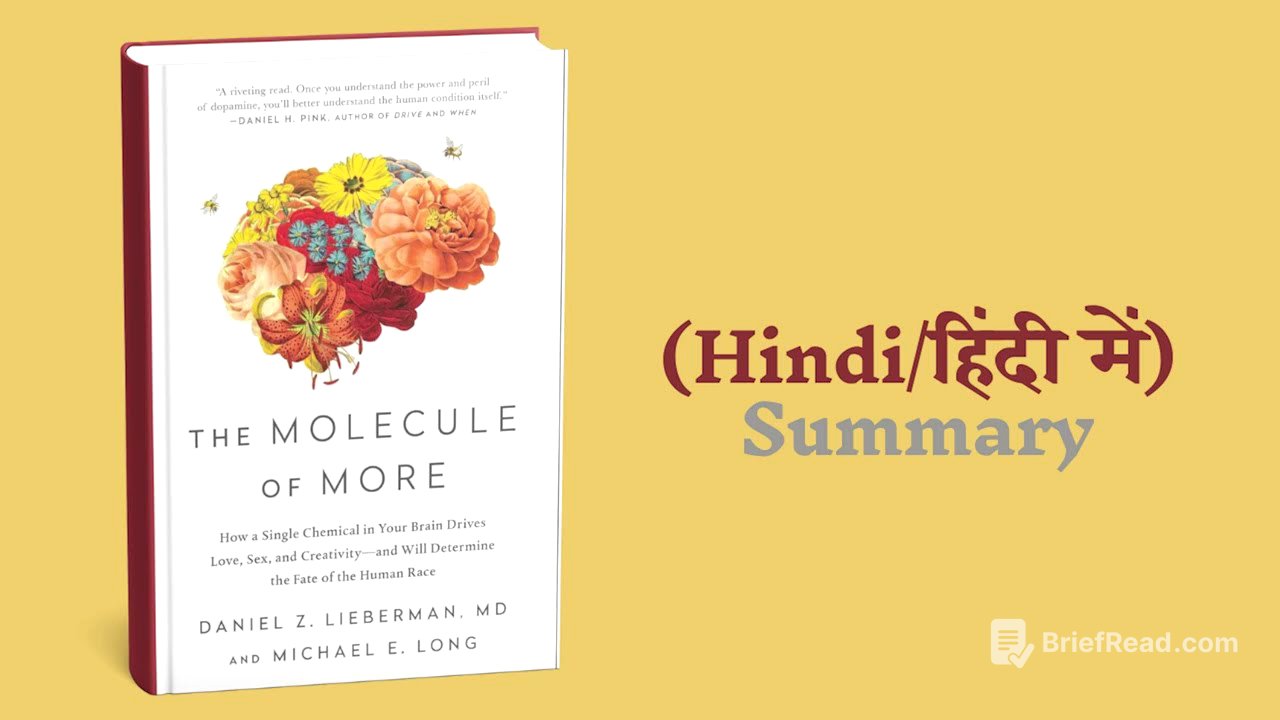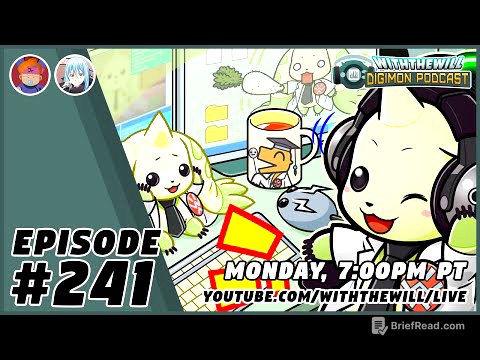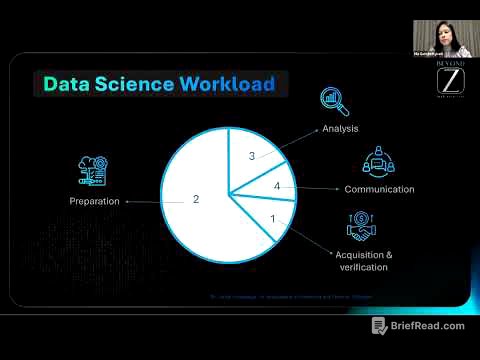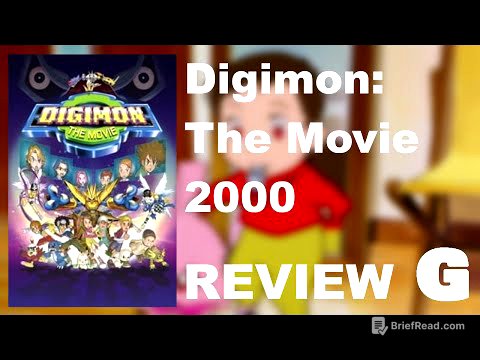TLDR;
This video summarizes "The Molecule of More," exploring dopamine's role in driving human behavior, from ambition and addiction to creativity and love. It differentiates between dopamine-driven desire and "here and now" satisfaction, highlighting the importance of balancing both for a fulfilling life. The video also touches on dopamine's influence on mental health, politics, and progress, emphasizing the need for control and harmony to harness its power effectively.
- Dopamine drives ambition, desire, and the pursuit of new experiences.
- Balancing dopamine with "here and now" satisfaction is crucial for happiness.
- Dopamine influences addiction, creativity, mental health, and even political ideologies.
- Control and harmony are essential to harness dopamine's power constructively.
The Molecule of More [0:03]
The book "The Molecule of More" explores dopamine, a molecule that influences our dreams, desires, and decisions. Dopamine activates the body when pursuing something new, whether it's career growth, relationships, or adventures. The book explains how dopamine controls our lives, sometimes leading to obsession and destruction, and how it has shaped human evolution, influencing every decision we make.
Looking Up vs. Looking Down [1:29]
The video contrasts "looking down" at things immediately available and controllable with "looking up" at things that require planning and effort to achieve. The brain uses different chemicals to manage these two perspectives: neurotransmitters for satisfaction with the present ("here and now") and dopamine for the desire to attain what is distant. Dopamine drives us to seek new things, rewarding obedience and tormenting when ignored, fueling creativity but also potentially leading to madness and addiction.
Dopamine Discovery and Function [6:06]
Dopamine, discovered in 1957, was initially thought to be a precursor to noradrenaline. Although only a small percentage of brain cells produce dopamine, it has a significant impact on behavior. Activating dopamine pathways leads to feelings of pleasure and the desire for repeated activation. While some scientists consider dopamine the "pleasure molecule" and its pathways the "reward circuit," others believe it evolved to motivate survival and reproductive activities, not just drug addiction.
Dopamine: Excitement and Anticipation [8:45]
Dopamine is not about pleasure itself, but about excitement and anticipation, fueling the quest for love, creativity, success, and even spiritual fulfillment. Dopamine surges when a rat receives a food pellet, but the effect diminishes if the reward becomes predictable. Random rewards, like those in slot machines, create a dopamine-fueled excitement that drives compulsive behavior. This principle, based on Skinner's behavioral science research, is used by casinos to maximize profits from slot machines.
Love and Dopamine [11:21]
Early love is driven by dopamine, creating excitement for new things, but this passionate love typically lasts only 12 to 18 months. To make love long-lasting, it must transform into companionate love, which relies on serotonin, oxytocin, and endorphins for stability and companionship. Dopamine compels chasing, while "here and now" molecules keep us grounded in real relationships. In long-lasting love, dopamine is replaced by oxytocin and vasopressin, promoting bonding and stability.
Drugs and Dopamine [13:17]
The video explores the difference between wanting and liking, illustrating how dopamine drives us to pursue things that don't necessarily bring satisfaction. Dopamine is produced in the ventral tegmental area (VTA) and released into the nucleus accumbens, creating motivation. This system, designed for survival and reproduction, can be hijacked by addictive drugs, which deliver intense chemical blasts to the desire circuit, overshadowing all other priorities.
Addiction and Dopamine [18:23]
Addictive drugs create a dopamine hit that no natural behavior can match, leading addicts to prioritize drugs over everything else, including survival. The dopamine system in an addict's brain tells them that choosing drugs is the most logical choice. Unlike natural dopamine triggers, which end when a need is met, drug use continues until the addict is incapacitated. Addictive drugs bypass the natural reward prediction process, confusing the brain and linking every situation to drug use.
Overcoming Addiction [22:11]
Satisfying a craving doesn't necessarily lead to pleasure because wanting and liking are two different things; dopamine makes promises it can't keep. Research shows that dopamine boosts desire but not necessarily liking, while "here and now" boosters increase liking responses. Opioids and marijuana are highly addictive because they trigger both dopamine and "here and now" systems. Impulsive behavior, driven by dopamine, overpowers rational parts of the brain, leading to decisions that are not in one's best interest.
Dopamine and Impulsive Behavior [24:34]
Dopamine-boosting drugs also boost impulsive behavior, leading to compulsive use. Excessive stimulation of dopamine overpowers the ability to like or hate, making the desire uncontrollable. Even some prescription drugs that boost dopamine for conditions like Parkinson's disease can trigger high-risk behavior. Pornography and video games also trigger dopamine, with unpredictable rewards in games keeping dopamine active and potentially leading to addiction, especially in children with less impulse control.
Dopamine Control Circuit [28:38]
The dopamine desire circuit is opposed by the dopamine control circuit, located in the frontal lobes, which enables rational decision-making, future planning, and long-term goals. This control circuit can put the brakes on dopamine cravings and keep us in control. Dopamine forces us to navigate complex situations to control our environment, planning and strategizing to dominate the world around us.
Dopamine and Domination [29:57]
Dopamine desire circuits provide raw energy, while dopamine control circuits focus on planning and execution. Self-efficacy, the belief in one's ability to succeed, is crucial for motivation. While dopamine-boosting drugs can create an illusion of self-efficacy, they can also lead to overconfidence and dangerous behavior. Appearing confident can lead others to let you dominate, as people unconsciously retreat from those who seem strong.
Dopamine and Emotional Control [34:09]
Dopamine controls circuitry that enables imagination and planning, creating strategies to improve the future. Dominance means complete control over the environment, whether through direct power or submissive strategies like diplomacy. Weakness in controlling dopamine can lead to impulsivity, as seen in ADHD, which is treated with dopamine-boosting drugs to strengthen control circuits.
Dopamine and Unethical Behavior [35:35]
Dopamine doesn't care how victory is achieved, whether honestly or dishonestly, and reduces feelings of guilt. Cold, calculated violence is dopamine-driven, suppressing emotions and focusing on calculations. A dopamine-driven person focuses on the future, ignoring the joys of the present, and may suppress emotions to maintain a cool-headed response in crises.
Dopamine and Emotional Distance [38:40]
People with a higher density of dopamine receptors tend to be emotionally detached and cold, while those with low density are nurturing and easily exploitable. Dopamine is activated when a situation is distant, promoting rational, emotionless thinking, while "here and now" circuits are activated in close situations, leading to warm, emotional reactions. Balancing dopamine and "here and now" circuits is essential for maintaining humanity and creating effective survival strategies.
Willpower and Dopamine [40:16]
Willpower is like a muscle that gets tired with use. Resisting temptation weakens willpower, but it can be strengthened with exercise and correct feedback. Motivational Enhancement Therapy (MET) uses desire against desire, boosting positive desires to overcome negative ones. Cognitive Behavioral Therapy (CBT) uses control dopamine against desire dopamine, teaching addicts to identify and eliminate triggers. Addiction changes brain chemistry, weakening control dopamine and making recovery more difficult.
Dopamine and Creativity [43:16]
Creativity connects seemingly unconnected things, but mental illness can make life challenging. Both creativity and madness are linked to dopamine, with madness and genius being closely connected. Schizophrenia involves hallucinations and delusions, where even normal things seem strange. Creative people sometimes experience thought overload, and if the balance is disturbed, creativity can lead to madness.
Dopamine, Models, and Imagination [46:12]
Creativity involves building and breaking down models to see them in new ways, with dopamine boosting this process. Overactive dopamine circuits can lead to a shift from creativity to madness. Models are imaginary representations that help us understand the world, and dopamine allows us to experience a future that is not yet real. Breaking old models leads to new possibilities, but sometimes creativity and madness can mix.
Dopamine and Genius [48:25]
Dreams and creative thought share similarities, with the mind becoming free from physical reality and generating new ideas. Overactive dopamine circuits can lead to a mix of imagination and reality, blurring the line between creativity and madness. Both science and art are driven by dopamine, with both poets and scientists relying on imagination and abstract ideas. High dopamine levels in geniuses can lead to social awkwardness and a focus on ideas over relationships.
Dopamine and Politics [50:57]
Genetics, including the D4 gene, can influence political ideology, with certain variants linked to novelty-seeking behavior. News focuses on short, catchy stories to deliver an instant dopamine hit, weakening serious discussion. Fear works because people fear losses more than they value gains, with negative reactions being stronger during losses. Amygdala plays a role in processing fear and negative emotions.
Dopamine and Loss Aversion [54:30]
In losses, dopamine gives a gain payoff of +1 and a loss payoff of -1, but the "here and now" system also gives -1 on loss, making the overall loss feel like -2. People hesitate to give away their things due to loss aversion.
Dopamine and Progress [54:48]
Human migration may be linked to dopamine, with the 7R allele of the DRD4 gene increasing risk-taking and novelty-seeking. People with this gene are better at adapting to the environment and feel less stressed, aiding survival. Bipolar disorder involves high levels of dopamine, leading to high energy and impulsiveness, but also overloading the brain.
Dopamine and Identity [57:44]
Dopamine cells make up only a small percentage of the brain, but they shape our identity. Dopamine drives us to live in imagination and possibilities, sometimes ignoring reality and losing real happiness.
Dopamine and Harmony [58:49]
Mastery provides satisfaction to dopamine by maximizing reward and fostering an internal locus of control. Focusing on the present moment and exploring reality through sensory input keeps dopamine and "here and now" in balance. Creativity brings together dopamine and "here and now," providing both thrill and peace of mind. Balancing dopamine with "here and now" is essential for achieving real happiness, avoiding disillusionment and stagnation.









